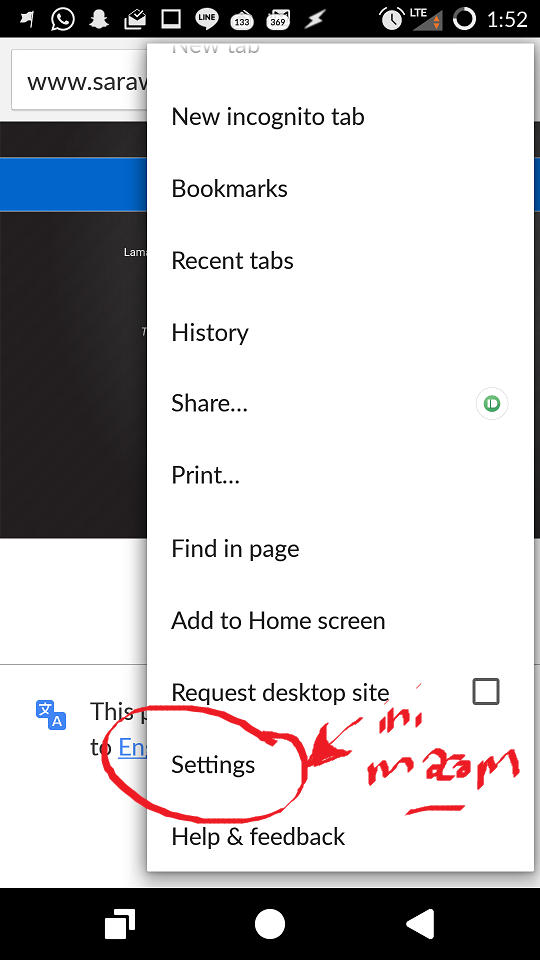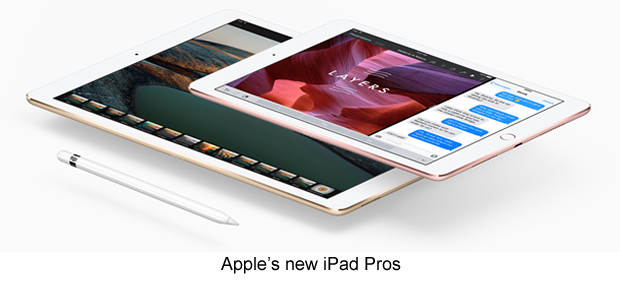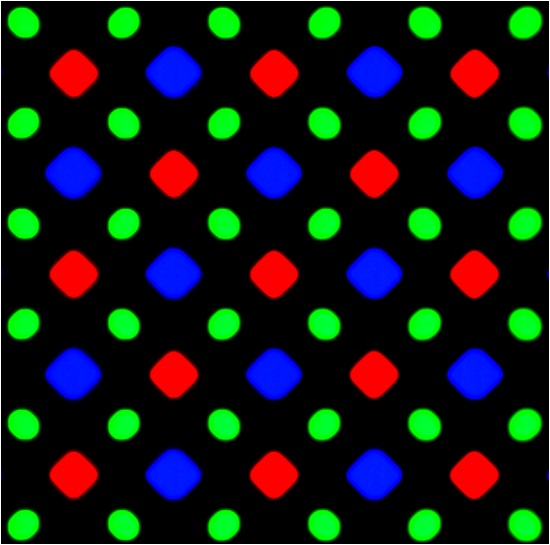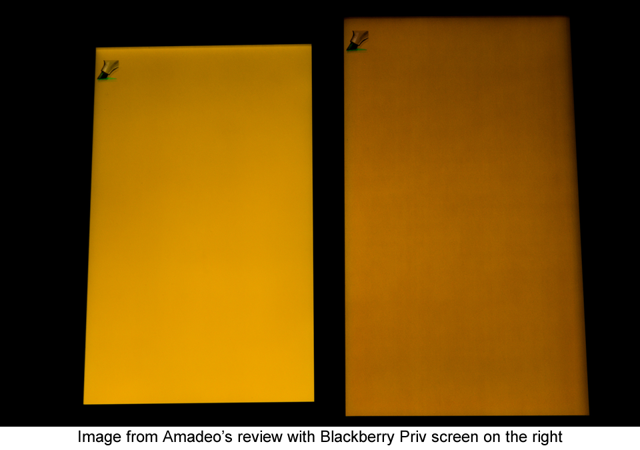Why Would Apple Buy Displays From Samsung?
Summary
The Korea Herald has reported that Apple has selected Samsung OLED displays for use in the 2017 iPhone.
Apple may have found a better screen technology in its new 9.7 in iPad Pro.
Business considerations probably weigh against a partnership with Samsung in any case.
Recent
reports out of Korea that Apple (NASDAQ:
AAPL) plans to use Samsung (
OTC:SSNLF)
OLED displays for iPhone starting in 2017 ignore a number of technical
and business considerations. The common belief that OLED displays are
superior to LCD is debatable. Furthermore, the fierce competition
between Apple and Samsung argues against a supplier relationship that
would make Apple once again dependent on Samsung for a critical iPhone
component.
Consider the Source
Since
Samsung and many other Apple competitors started using Active Matrix
Organic LED displays (AMOLED), it's become a common criticism of Apple
that its displays were inferior. This was pointed to by Apple critics as
yet another area where poor old clumsy Apple was falling behind the
times.
Apple has often been an early adopter of technologies such as AMOLED. In fact, one criticism I've heard is that Apple is merely
an early adopter, and doesn't originate technology development of its
own. Why then has Apple not jumped on the AMOLED bandwagon?
The
usual explanation is that Apple is just defending its margins, and LCD
offers lower cost compared to LCD. That might be true, but I'm not
convinced that would restrain Apple significantly. Also, AMOLED
manufacturers are arguing, with justification, that the bill of
materials is smaller. AMOLED displays are simpler, requiring no
backlight. If AMOLED really offered a superior display, Apple would
probably be attracted to it by virtue of being simpler, lighter and
thinner.
In fact, the claim that
AMOLED displays are superior ignores many of the problems with them, and
these problems are largely ignored by the media. The most important
problems with AMOLED are the limited display lifetime, especially of
blue pixels, and color and intensity non-uniformity across the display.
The
limited lifetime of blue OLED materials is well known and is the
subject of ongoing research. Dr. Steve Forrest, a researcher on the
subject at the University of Michigan last year
summarized the state of the art. Blue pixels typically last less than 1% as long as the green and red pixels.
To
help blue pixels last longer, AMOLED screen makers typically make them
bigger, as can be seen in this magnified image of the Samsung display
layout used for the Galaxy S6 and S7.
OLED
pixels don't die a sudden death, but decline gradually in light output
from day one, depending on the amount of use and operating brightness.
For that reason, OLED displays are subject to burn in, which isn't a
problem with LCDs at all. What's burn in? If you need to ask, you're too
young to remember the olden times of pre-LCD televisions.
Burn
in is where a very bright image leaves a permanent after-image in the
screen. Screen savers were devised to reduce this effect by continually
changing the content of the screen. Screen savers stopped being
necessary once LCD displays became prevalent.
In
addition to burn in, AMOLED displays are subject to considerable
response non-uniformity, which can produce a grainy image when
displaying a uniform color. This problem is hardly ever treated in
reviews of AMOLED display. I've only seen one review that even broached
the subject,
Ron Amadeo's review of the Blackberry (NASDAQ:
BBRY) Priv in Ars Technica, which suffered from particularly severe non-uniformity.
Even
though reviewers tend to ignore the problem, one can find plenty of
anecdotal evidence that it's still an issue in various Android
discussion forums. Even Samsung's latest
Galaxy S7
has received complaints. Complaints are not confined to the S7. One can
find similar complaints about almost any phone that uses an AMOLED
display, including the
Nexus 6P, and the
One Plus. In the the
Galaxy S6: The Ugly Truth About Its Screen, one unhappy owner posted a series of photos detailing the problem, as shown below.
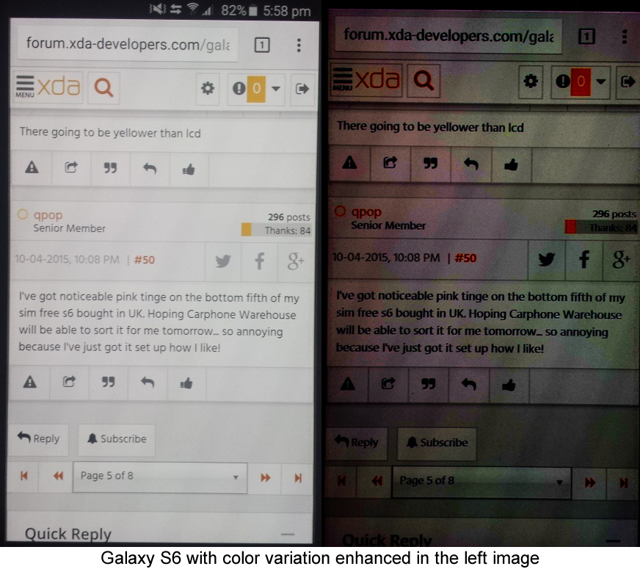
In his
recent review of the S7's display,
Dr. Raymond Soneira (Displaymate) alludes to the improvement in
uniformity of the display, but offers no quantitative measurements. Dr.
Soneira provides excellent, comprehensive technical reviews, and I wish
he would address this issue. All displays, including LCD, suffer from
some non-uniformity artifacts of various types, and it would be
interesting to get a better feel for how Samsung's AMOLED displays
compare to other AMOLED and LCD displays.
Perhaps
the biggest drawback of OLED is that it's less power efficient than LCD
when the background of the display is mostly white. This is not an
uncommon scenario. When reading an ebook, or visiting most web sites,
the background is predominantly white.
Pointing to the Near Future
Dr. Soneira has generally favored OLED screens for having better color and contrast, but his recent
review of the screen 9.7 inch iPad Pro
probably indicates where Apple is going for the next few years. The Pro
set new standards for LCD screens in terms of color gamut and
brightness. Color gamut pertains to the saturation and richness of the
color as seen by the human eye. Most displays don't achieve the full
range of color that the eye can perceive. The iPad Pro comes very close
to the gamut of the S7, which has been a key area of superiority for
AMOLED.
The Pro also is brighter
than the S7 when displaying an all white background. Although AMOLED has
higher contrast ratio (when viewed in the dark), the Pro's contrast
ratio when viewed in bright light conditions was actually better than
the S7. Under typical usage scenarios, the Pro provides a better
experience, and uses less power.
The reader is
probably wondering why Apple chose AMOLED for Apple Watch. Here, the
difference is usage scenario. Most of the time, the background of the
Watch is kept dark. In this scenario, AMOLED is more efficient, and this
would be a key consideration for Watch battery life. Most of the time,
users aren't reading a lot of text, such as an ebook, and messages can
be displayed with white characters on a black or dark background.
The
improvements in the 9.7 inch Pro display are so substantial that they
probably cancel any perceived advantage that AMOLED might offer in terms
of color accuracy and contrast. The sole advantage that AMOLED might
have is in being lighter and thinner. But this is offset by the need for
a larger battery to support use of the screen for light backgrounds.
For instance, the battery of the S7 is 3000 mAh vs. the 2750 mAh battery
of the larger iPhone 6s Plus.
Business Considerations
While
the technical considerations for AMOLED are debatable, business
considerations will probably have the final say. Apple and Samsung are
locked in a fierce and acrimonious competition. Apple has waged a legal
battle against Samsung's violations of Apple's patents. Apple is
shifting its processor production to TSMC (NYSE:
TSM), even though it used Samsung for part of the production of the A9 processor for the iPhone 6s.
When
Apple signs up a supplier, it is in effect agreeing to share profit
with that supplier. Why would Apple want to share profit with Samsung?
The rumor really doesn't take into account the bad blood that must exist
between the managements of the two companies.
The rumor also doesn't take into account the recent purchase of Sharp by Foxconn (
OTC:FXCOF), in which
Apple may have played a part. Sharp was
reported
to be the supplier of the screen for the larger iPad Pro, and I think
it's likely that Sharp is the supplier of the 9.7 inch Pro display as
well. Regardless of Apple's involvement with the Sharp purchase, I doubt
Foxconn would have bothered with Sharp if it didn't have a ready
customer in Apple for Sharp's display output.
This says at the very least,
Sharp/Foxconn will be the preferred supplier for Mac and iPad displays
for the next few years. Since volume is really in iPhone, probably
Sharp/Foxconn will be the preferred supplier for iPhone as well. I
consider this probable by virtue of the excellent display performance
achieved in the 9.7 inch iPad Pro.
Even if Apple
were to elect to use AMOLED for iPhone, it would probably prefer to stay
clear of Samsung and use its current supplier of AMOLED displays for
the Apple Watch, LG. LG was
reported to be expanding its OLED production capacity, and this might have been in anticipation of increased demand for OLED for a future iPhone.
Investor Takeaway
The
rumor, coming as it does out of Korea, really amounts to a not very
subtle putdown of Apple. It's a statement that Samsung's display
technology is so superior that Apple will elect to use it despite all
that has transpired between the two companies.
I
seriously doubt it. I think it's possible that Apple may skip AMOLED
altogether in favor of an emerging technology, the quantum dot OLED or
QLED.
The advantage of QLEDs would be that the blue pixel would be as
efficient and long-lived as the red and green pixels, thereby solving
one of the major problems of current AMOLED displays. Quantum dot
technology is already in use to improve the color gamut of LCD
backlights, and may even be used in the 9.7 inch iPad Pro.
Apple
doesn't have much to gain from using AMOLED, but it has a lot to lose
in terms of market credibility by turning to Samsung as a display
source. I believe Apple management fully realizes this and will steer
clear of Samsung. I remain long Apple and recommend it as a buy.
Disclosure: I am/we are long AAPL.
I wrote this
article myself, and it expresses my own opinions. I am not receiving
compensation for it (other than from Seeking Alpha). I have no business
relationship with any company whose stock is mentioned in this article.
Editor's Note: This article discusses one or more
securities that do not trade on a major U.S. exchange. Please be aware
of the risks associated with these stocks.
http://seekingalpha.com/article/3965705-apple-buy-displays-samsung
